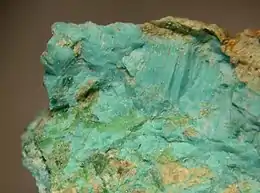Moolooite
Moolooite is a rare blue-green mineral with the formula Cu++(C2O4)·n(H2O) (n<1) (copper oxalate hydrate). It was discovered by Richard M Clarke and Ian R Williams in Bunbury Well, Mooloo Downs station, Murchison, Western Australia in 1986.[3] It has an orthorhombic crystalline structure, and is formed by the interaction of bird guano with weathering copper sulfides. It is used in plastics to color them blueish-green.
| Moolooite | |
|---|---|
 Blue massive moolooite (field of view 12 mm) | |
| General | |
| Category | Oxalate mineral |
| Formula (repeating unit) | Cu(C2O4) · 0.4H2O |
| IMA symbol | Moo[1] |
| Strunz classification | 10.AB.15 |
| Crystal system | Orthorhombic |
| Crystal class | Dipyramidal (mmm) H-M symbol: (2/m 2/m 2/m) |
| Space group | Pnnm |
| Identification | |
| Color | green |
| Specific gravity | 3.43 (calculated) |
| Density | 2.6 |
| References | [2] |
A second occurrence is reported from the Sainte-Marie-aux-Mines silver mining district of Vosges Mountains, France.[3]
References
- Warr, L.N. (2021). "IMA–CNMNC approved mineral symbols". Mineralogical Magazine. 85 (3): 291–320. Bibcode:2021MinM...85..291W. doi:10.1180/mgm.2021.43. S2CID 235729616.
- Mineralienatlas
- Clarke, R.M.; Williams, I.R. (1986). "Moolooite, a naturally occurring hydrated copper oxalate from Western Australia" (PDF). Mineralogical Magazine. 50 (356): 295–298. Bibcode:1986MinM...50..295C. doi:10.1180/minmag.1986.050.356.15. S2CID 54527532.
This article is issued from Wikipedia. The text is licensed under Creative Commons - Attribution - Sharealike. Additional terms may apply for the media files.